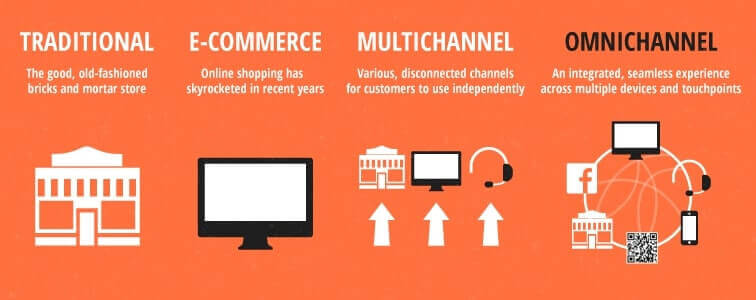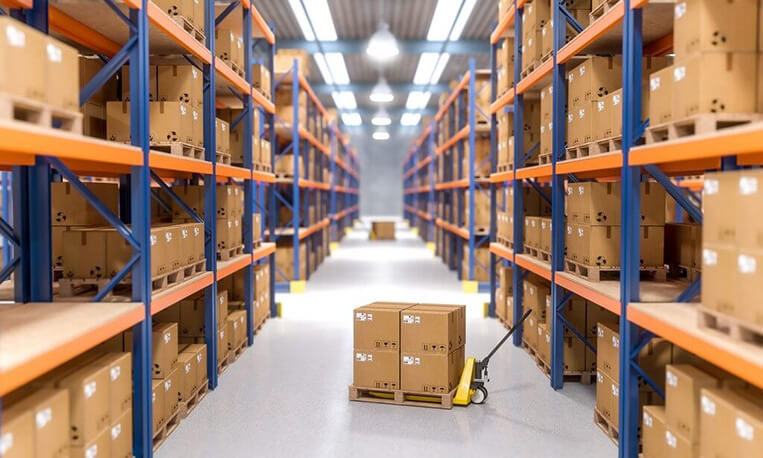Chapter 1: Prepare your omnichannel approach on Magento
Pursuing omnichannel retail on Magento isn’t for everyone. To achieve omnichannel, you need to meet customer expectations by upgrading crucial business operations. Then, we’ll consider Magento capabilities, including its core and ecosystem, in meeting your goals. With this information in hand, you’ll have the right preparations for your omnichannel success.
89% of existing customers are retained by companies with omnichannel engagement strategies. The number is only 33% for companies with weak omnichannel engagement.
Source: Invespcro
If you haven’t rolled out any omnichannel strategies by now, you’d better get started soon.
Omnichannel, in short, is to ensure consumers easily and seamlessly go from one channel or device to another to make a purchase.

Source: SnapRetail
Fact: Building omnichannel retail on Magento is not for everyone. It’s recommended for Magento retailers who have:
- Sales operations set up well and running stably
- Budget is not strictly limited
Why? Going omnichannel is costly and complex. It’s a long process, rather than an overnight success:
- Omnichannel is connecting to unify the sales & operations on all channels. Retailers with weak sales operations are busy making a profit to sustain the business. They can’t focus on spotting and improving their loose wheel.
- Omnichannel requires a considerable investment, especially in an order management system. Hence, your budget should be flexible enough to cover the losses before actually taking results.
Startups and small-sized businesses may face higher risks in pursuing omnichannel from the start. The best strategy is to go with multichannel first, then aim at omnichannel when they feel confident in their resources.
Within the scope of this Magento Omnichannel Retail guide, we will focus on building omnichannel retail on Magento Open Source version (previously known as Magento Community). Knowing the possible challenges and Magento capabilities will prepare you for your omnichannel success.
Why Magento retailers should adopt the omnichannel approach
The shift in customers’ shopping behaviors
Modern consumers shop across multiple channels and devices. They may find something online and head to an outlet to try and buy it. Or, they arrive at a store, intending to buy a product but the store doesn’t have the correct size. Then they use their smart device to check online inventory and make the purchase.
85% of customers begin the purchase process on one device before finishing it on another.
Source: Google digital trends study
Thanks to the exposure of smart devices and the internet, consumers now can easily find all the information they need. Whether product specifications, buying policy or supplier comparison – all are available in some clicks. Even better, they can buy a product online and get it delivered to their home. So they can make the purchase whenever and however convenient, not necessarily in a place or using one method.

Source: business2community.com
Moreover, modern consumers are “channel-blind”.
They only care about getting the product/service they need. No matter how many channels or devices they use to shop, the experience should be unified. Each of these channels is interconnected to provide a seamless purchase journey. Consumers want no gaps or misalignment when navigating from one channel/device to another.
The need for a centralized system to manage multi-channel sales
As a result of higher customer expectations, Magento retailers are encountering two huge challenges. You need to deal with a fast-paced competition and come up with technologically innovative solutions to manage their retail businesses at the same time.
The growth of mobile and social preferences has led to intense retail competition. When information is transparent on the internet, consumers can easily find, compare and take offers from different suppliers. They have a variety of choices to buy from instead of retaining their loyalty with a specific brand. If you can’t provide a satisfying experience, they’ll leave.
47% of customers are willing to shop at a competitor if they continuously encounter poor customer experience.
Source: forbes.com
From another perspective, retailers now have more chances than ever before to increase sales. Online or on the street – there are several ways to catch the attention of your prospects. Research from IDC found that consumers shopping via multiple channels have a 30% higher customer lifetime value than single-channel shoppers.
In short, in the omnichannel era, retailers have new opportunities to get potential customers, but also, to lose customers to competitors if they can’t meet their expectations.
However, selling and operating on different channels requires tremendous effort.
The omnichannel era requires an omnichannel management system. The lack of inventory transparency often leads to costly overselling or underselling situations. Managing orders from multiple channels are prone to errors and delays in delivery. At the same time, retailers need to offer a personalized experience in tune with their branding and catch up with new technologies before their competitors gain the edge. It’s overwhelming doing everything at once. Without a proper management system, a retailer can hardly survive, let alone delivering a good shopping experience.
What consumers want from an omnichannel shopping experience
Consistency across sales channels
Omnichannel shoppers demand transparent and consistent information on all channels they visit. The information can be product availability in-store, store location, working hours and pricing. It significantly affects their purchase decision, according to a study by Forrester. When the information isn’t available, shoppers may stay away.
39% of consumers are unlikely or very unlikely to visit a retailer’s store if the online store doesn’t provide physical store inventory information.
Source: Thinkwithgoogle.com

Source: Think with Google
Transparent information encourages customers to make the purchase faster. For example, a shopper can pre-search a T-shirt on your website. Then, they drive to the nearest outlet to try it on and make the purchase. By the time they arrive at the outlet, they wouldn’t want to learn that the T-shirt is actually out of stock. And the fault belongs to the wrong information displayed on your website. You can imagine their anger for wasting their time. And you’ll probably lose the customer forever. What they should get, instead, is a smooth shopping journey, from your website to your physical store, without unexpected incidents.
Providing all the information they need, you are actually preventing them from distractions (most come from your competitors!) to focus on buying your products. This later translates into more conversions and a better brand image.
Again, managing multiple channels isn’t easy. It’s a long process which takes time and costs. But the results are totally worthwhile.
Flexible order fulfillment options
Timely delivery is crucial because it affects the satisfaction of the buyer. Modern customers want to receive their products in the least time with the least effort.
60% of shoppers would switch retailers if their delivery option wasn’t available.
Source: Kibo’s Digitally Demanding Consumer report
In the past, if a customer needs a product urgently, they may drive to your store to buy it. But now, they will buy it online and select the fast shipping option to get the delivery within 24 hours. Or they may make the purchase online at their office, then pick it up from your store on their way home from work.
Omnichannel is all about seamless integration that breaks down all gaps from shopping to delivery. To consumers, it’s the possibility to combine physical stores, web stores, social media and marketplace listings to make one purchase. To retailers, it means integrating purchase points with delivery points seamlessly, in a single system that is controlled from a single point.
On the other hand, modern consumers are tech-savvy. They don’t mind trying a new way to get the products they want. But keep in mind their demands: quick, easy and cheap. So you may not need to offer all shipping options available in the market, but focus on what really works for your customers. Some popular examples of fulfillment methods are:
- Buy online, pickup in-store (also called click and collect): attractive as a cost-saving with $0 shipping fee
- Ship from store: shorter delivery time by selecting the nearest store to the customer’s location
- In-store purchase, home delivery: effortless shipping for customers when buying big or bulky products, or when customers need to go elsewhere after shopping at your store

In-store pickup line at Target
Personalized experience
As said previously, modern shopping triggers a tough competition. Customers are drowned in too many offers every day. With many sellers offering the same products, customers have many choices. They easily look elsewhere to shop when not happy with their shopping experience.
And the competition isn’t only among neighboring retailers but also against giant commerces like Amazon or eBay. Big corporations have more budget to maintain different shopping channels and implement several fulfillment methods. It seems easy for them to dominate the smaller ones with the advanced services that they provide. Medium-sized retailers can’t strive if they can’t offer a memorable experience.
The future of retail isn’t about who has the best widget or offers the highest coupon. It’s about who makes their customers feel the best in doing business with them. A good shopping experience engages customers with a brand and keeps them coming back.
Repeat customers spend 300% more money than one-time buyers. Return customers would also likely to buy your more expensive products or services.
Source: investopedia.com
Recommending “similar products” to a consumer is no longer enough.
There’s no point in recommending products to customers that already have it or are not interested in buying. Instead, try to create an exclusive experience of what they like or dislike. The key is to deliver the right message to the right customer at the right time. Different customer segmentation should receive different offers based on historical behavior. The data updates are in real-time throughout all sales channels. The strategies shouldn’t stop at closing a deal but also to enhance customer loyalty.
With the proper approach and technological system, retailers can provide a personal experience across all customer touch points. You can learn to create your own omnichannel strategy in chapter 3 of this Magento Omnichannel Guide.
How Magento leads you to omnichannel
When it comes to eCommerce platforms, Magento is a market leader. Many retailers worldwide have chosen Magento as their success base.
167 of the Top 1000 merchants use Magento as their eCommerce platform.
Source: Internet Retailer
Magento built-in modules provide in-depth eCommerce management that no other platforms can compete. Magento supports multiple seller accounts, pure ownership of data and products, multi-currency, real-time tracking of specialized product types, inventory control, etc.
In the most recent release, Magento 2.3 has included Progressive WebApp (PWA) in its core. PWA has become a hot topic among Magento community. It’s promising to change the way developers build mobile experiences.
Magento Open Source version is 100% free. Using this open-source platform, retailers can start simple first and upgrade as they grow. Going omnichannel is quite expensive while few merchants can afford a huge investment at a time. And there’s no guarantee in quick turnarounds. Scalability by demand is the best path for their omnichannel journey.
One of your upgrade options is Magento Order Management. It’s ideal for businesses with multiple brands, sites, stores, warehouses. Magento Business Intelligence (BI) provides smart analytics to learn your top customers, products, and promotions and find new opportunities. Or, you can upgrade to Magento Commerce (previously known as Magento Enterprise). This paid version provides more powerful functions like drag-and-drop page builder or mobile commerce.

Source: magesolution.com
Magento also has a huge community including merchants, partners, and developers. This global ecosystem provides a variety of extensions and responsive themes.
In implementing omnichannel on Magento, the following areas are crucial to ensure accessibility across channels and enhance customer experience at the forefront.
Sales activities
Why this operation is important
The omnichannel approach is born as shoppers expect to buy seamlessly across sales channels. Customers can shop online from a computer, a smart device, by telephone, or in a brick and mortar store and the experience should be unified as one.
Key requirements in this operation
Omnichannel retail focuses on every customer interaction with your brand. Most of these interactions come from sales. To achieve omnichannel in sales activities, retailers should provide the followings:
- Real-time and correct data sync between all front stores (website, physical stores, mobile app, etc.) and back-office (Magento system)
- The flexibility to sell and checkout anywhere in the shop. Sales staff can use a smart device to provide in-depth consultation and convert faster
- Transparent information of products in-stock. This feature is helpful in case a product runs out-of-stock in one store. Instead of losing sales, the cashier can check stock levels at other stores to fulfill for the customers later. Retailers also avoid deadstock at the other stores.
- The ability to sell different products at custom prices in different locations. The store owner still manages all data in Magento only.
- Advanced level: Self-checkout at the brick-and-mortar store. A self-service checkout saves time for both customers and cashiers. However, few retailers can achieve do this without cautious planning for theft and infrastructure.
67% of surveyed customers prefer self-service over speaking to a company representative.
Source: zendesk.com
Capability of Magento & its ecosystem
In terms of sales, Magento has clear privileges not only on your eCommerce website, especially with the release of Magento 2.3.
- For selling on the website, Magento is well-known as the top eCommerce platform. Retailers can sell any type of product, no matter how complex it is. And you can control everything including inventory, orders, customers, etc. in real-time in Magento admin. Magento Commerce version makes it even easier to create a website with Page Builder feature. You can drag and drop elements without technical skills.
- For selling on mobile, Magento embraces Progressive WebApp (PWA). This technology combines the best of the app and the best of the web. Users get a fast and smooth mobile experience right from their device screen.
- For selling on marketplaces, Magento can easily integrate with Amazon to provide an additional way for conversion.
- Magento also supports Google Shopping ads to re-target customers who have performed specific behaviors on the website.
- If you sell internationally, you’ll love Magento. Multiple store view feature allows you to sell different products at price range, language, tax in different regions. It also has 150+ language packs to localize your website.
Besides Magento’s rich features in online sales, its ecosystem complements retail power, especially in the “offline” part:
- For selling on social media, you can find several extensions at reasonable prices. Customers can register on your website using their account on Facebook, Twitter, Google, Pinterest, etc. They can directly share any page of your store in a click. It’s helpful both for increasing sales and brand awareness.
- For selling in physical stores, a point-of-sale (POS) system is the key for success. It delivers a fast checkout in-store. There are different types of POS software, but omnichannel retailers must invest in an integrated POS system. This system provides real-time data update between POS & Magento and the ability to sell all types of products that Magento supports. Some advanced solutions like Magestore POS let you adjust stock directly on POS and view stock levels at other stores on POS screen. Magestore is the first to apply PWA to POS system for exceptional performance. It’s fully customizable to meet your specific needs. You can even sell for multiple store views from 1 POS.
- Barcode scanning at the checkout counter to correctly and quickly add items to the customer’s cart
- Extra extensions and plugins to optimize your website. You can get these Magento-native extensions from providers like Amasty, Aheadworks, etc.

POS System is the key for seamless in-store checkout
Loyalty & Customer Management
Why this operation is important
69% of consumers say that they will choose to shop where they can earn customer loyalty/reward program points.
Source: invespcro.com
Invespcro survey also shows that 50% of customers are willing to change their behavior to reach a higher tier of the loyalty program. Obviously, an omnichannel retail strategy can’t be complete without a customer loyalty program. Rewards and discount codes are useful incentives to attract price-sensitive shoppers who are euphoric for good deals.
Loyalty programs also provide a personal shopping experience to retain customers. You can sell slow-moving stock faster or get new customers by rewarding your existing customers upon buying a product or referring to their friends. Customers also love to receive gifts on special occasions like their birthday or 1-year-shopping with you.
Key requirements in this operation
- Central management of all customer data (including order history, loyalty points, loyalty history, etc.) on Magento with the ability to set different promotions on different sales channels
- The ability to create different promotions targeting different customers by custom behavior-based rules
- Seamless integration with Magento and POS so that loyalty points are applicable and redeemable at any touch points (on website, at physical store or kiosk, on mobile)
Capability of Magento & its ecosystem
Magento core already covers 2 types of custom discounts where retailers can reward customers based on their shopping behavior. Customers can gain a discount automatically when they meet your pre-set conditions or using a valid coupon code. These discounts are applicable on specific products or the whole shopping cart.
It’s also possible to set up different pricing for different loyalty levels in Magento. Tier pricing lets you offer a discount for a specific customer group when they buy in bulk. It’s one of the best promotional programs to encourage your customers to buy more.
Magento Commerce 2.3 also comes with a Reward Point program. It covers the basic level where customers can redeem or refund in points during checkout on the website.

Build seamless customer loyalty program
Whether you use the paid Magento Commerce or free Magento Open Source version, you have a variety of choices to provide advanced loyalty programs – all thanks to the huge ecosystem of Magento:
- Several free or affordable loyalty programs and promotion rules. Some of the most popular are Gift Card, Reward Points, Store Credits. Normally you can install these modules straight into Magento and control all loyalty data plus order history in Magento only.
- Banners and labels to highlight the promotions so customers can’t help noticing.
- These loyalty programs and promotions enhance customer’s experience in-store, if integrated seamlessly to Magento and POS like Magestore product does. Customers can use or send their loyalty balances both in-store or on website, even refund in store credits.
- Some POS allow custom discounts at the checkout counter so you can attract more customers to your outlet. This often increases the chance of an impulse buy.
Inventory & Warehouse Management
Why this operation is important
The fast-paced growth of omnichannel shopping behavior has kept many retailers playing catch-up. The reason is that most of these retailers still maintain separate inventory streams and order management systems for their different sales channels. They get lost in retaining an optimal level of inventory on hand while trying to meet and exceed demanding consumer expectations. In other words, they avoid overselling and underselling at the same time.
The problem becomes worse when you have more than one warehouse. Too often inventory shrinkage happens with unknown reasons, resulting in a big loss in profit.
Based on a 2018 survey by the National Retail Federation (NRF), Inventory Shrink Cost the US retail industry $46.8 billion.
Source: Forbes
Key requirements in this operation
- Inventory visibility across sales channels. Both customers and staff need correct and real-time stock updates anywhere, anytime to make the purchase and fulfill orders.
- Inventory management by bin-location/shelf location to locate and pick/pack orders faster
- Barcode support to ensure correct order fulfillment and prevent frauds. One great practice is to double-verify at the beginning of the picking process and right before packaging.
- Stocktaking with tiered staff permissions to monitor and reduce waste
- Ability to adjust stock at POS and the updates are instantly synced to Magento system
- For multi-warehouse owners: stock transfers inward/outward warehouses
Capability of Magento & its ecosystem
Magento is powerful in managing various types of products (configurable, bundle, virtual, etc.). Hence, complex businesses in a specialized industry find no difficulties selling their products/services to the market.
The recent release of Magento 2.3 comes with a dynamic inventory management feature. Multi-source inventory (MSI) is one of the most awaited releases that Magento has ever had. Merchants using MSI can now:
- Assign products to different fulfillment sources (e.g. warehouses, stores, distribution centers, etc) and track their quantities at each source
- Create rules to prioritize sources to fulfill orders for each website
- Quickly deliver an item in an order by making a separate shipment from a different warehouse, in case a customer wants to receive a particular item in advance
- Alert low levels of inventory to prevent stockout
- Track business performance by a suite of real-time reports

Inventory visibility across sales channels
Inventory management remains one of Magento’s greatest strengths, partially thanks to the help of its vigorous community:
- Advanced inventory and warehouse management modules to track inventory across all inventory sources. Stock transfers between inventory locations are now 100% paperless. Magento-native modules like Magestore solution is embedded into Magento admin. Hence, you always have real-time and correct inventory visibility both in-store (via POS) and on your website. All data remains nowhere else but Magento. These data includes products in warehouses, at outlets and upcoming from suppliers.
- In Magento 2.3, Magestore inventory management module lets you adjust and transfer stock directly on page.
- Barcode generator is available either in a free or paid extension. A barcode scanner makes managing thousands of SKUs faster and securer.
- Advanced inventory forecast based on custom threshold. Auto alert ensures you always have the right product amount on-hand.
- Track business performance by a suite of real-time reports
Procurement
Why this operation is important
As the number of sales and fulfillment channels increase, retail operations become complex. Retailers tackle the challenges of managing products across channels, aligning inventory and delivery, and coordinating with suppliers.
Customers often feel let down when you don’t have what they’re looking for. So it’s critical for retailers to match resources, especially stocks with demand. However, the purchasing activity of many retailers remains inefficient. This makes it difficult for them to reduce costs and to satisfy the demands of consumers.
To overcome these challenges, retailers have to do away with outdated procurement processes. Adopting new management that is better suited for today’s highly competitive market.

Centralize all purchases and suppliers in one place
Key requirements in this operation
- Manage all purchase orders and suppliers in a single-view system. Ensure smooth purchasing process
- Integrate purchasing, inventory levels with sales velocity to get rid of stockouts and overbuying
- Create purchase orders fast based on business trends. Monitor an end-to-end purchasing process
- Connect to the warehouse system to directly transfer stocks to desired warehouses
Capability of Magento & its ecosystem
Purchase orders (PO) in Magento are a promise for orders with prior authorization. There is no way to manage these purchase orders beyond PO number. So there is always room for Magento solution providers to enhance this default capabilities. Many advanced Purchase Management solutions are available to help you turn their tiny eCommerce store into a robust retail system:
- Provide you with a clear overview of supplier lists. Help you access the basic information like supplier names, products, and contact details. You can evaluate supplier credentials and pick the best that suit their budgets.
- Make it easy to convert POs from quotations or creates them manually. With advanced purchasing system like Magestore, it allows you to automate purchasing based on supply needs or low-stock notification.
- Monitor the end-to-end purchase process with different statuses
- Refill stock on time thanks to being integrated with inventory, sales channels, and reports
- Transfer purchase orders to desired destination warehouses, or return products with ease
- Use barcode scanners to add and receive purchase order faster and easier
Order Fulfillment
Why this operation is important
Running a retail business means that you have to deal with a high volume of sales orders every day. To meet the demands of omnichannel customers requires a quick and on-time response.
Yet, as retailers, it’s imperative to balance customer expectations with profitability. Having a well-functioning order fulfillment system is crucial to a successful omnichannel strategy. Many retailers devote endless hours to improving their system that helps:
- Deliver products to customers faster by using the closest possible fulfillment centers
- Reduce shipping costs while still meeting their expectations

Provide customers with flexible fulfillment options
Key requirements in this operation
- Centralize all orders in one system. Integrate with sales channels, inventory to keep data synced in real time. This helps execute flexible fulfillment strategies in the most efficient manner.
- Provide customers with flexible fulfillment options. Some popular model includes buy online, pick up in-store (BOPIS), ship-from-store, ship-to-store.
- Tracking end-to-end order fulfillment process (pick, pack, ship).
- Offer customers with ease of return. Your customer can visit the closest retail store or dropping it back into the mail.
- Ensure inventory visibility across all channels to accurately forecast the future demand
Capability of Magento & its ecosystem
Magento offers retailers basic order management capabilities. Amazon Sales Channel module, for example, is a free sales channel extension. It helps retailers seamlessly sell and distribute on the world’s largest marketplace:
- You can manage all your orders from Magento back-end. Ship or cancel orders, and build customer profiles with ease
- Use fulfillment by Amazon (FBA) to fulfill orders
Magento 2.3 introduces the popular fulfillment options like Click & Collect, or Dropship. Retailers now can add Click & Collect as a shipping method right from Magento store. This a great addition to your omnichannel strategy. Also, Magento gives retailers the flexibility to integrate with 3rd-party shipping.
However if your business needs an advanced order fulfillment system, Magento-native solutions are available for you:
- It’s necessary to mention Magento Order Management. This system is integrated with Magento Commerce. It gives retailers a centralized inventory and order management. The system helps gather all data from all these sources and create optimal rules for each order.
- Also, omnichannel fulfillment feature (built in Magento Order Management) lets retailers offer additional fulfillment options – buy online, pick up in store, ship-from-store, or ship-to-store.
- Advanced modules offer retailers the smart source selection algorithm. It helps select the suitable source to reduce delivery costs and time.
- Magento-native modules like Magestore solution help streamline order fulfillment process. Retailers can track item status with simple steps: pick, pack, ship.
- In case you want to reduce inventory holding costs, dropshipping can be optimal choice for your business.
Reports & Analytics
Why this operation is important
Managing multiple sales channels is hard. Making the right decisions is harder. Retailers need to get the right insights across the system. In other words, they need comprehensive reports to understand business performance. Most important data lie in sales, inventory and order fulfillment. By analyzing top customers, products, and promotions daily, retailers can explore new growth opportunities.
Analytics is also important in catching early trends in customer behavior. Omnichannel is about delivering a personalized experience based on in-depth insight. By embracing the fast pace of the modern market, retailers will retain their edge over competitors.

Reports help retailers make informed decisions
Key requirements in this operation
- Fully integrated inventory, procurement and order fulfillment data from one central point. You’ll always have correct and updated insights for decision making.
- Understanding business performance by identifying which channels or locations are making good profits
- Knowing who your top customers are to boost their satisfaction for brand advocacy
- Knowing which products are driving sales and which are slow-moving to develop the right strategies
Capability of Magento and its ecosystem
If you are using Magento 2.3, Open Source version already comes with a suite of several built-in reports. These reports cover sales, shopping cart, product, etc. It takes a few clicks to know how well a part of your online supply chain is performing.
If you’re a fast-growing retail business, you may want to consider an upgrade of Magento Business Intelligence (BI). You can define your own metrics to create an unlimited number of custom reports. This is the fundamental assistance to retailer’s performance boost.
As a pioneer in solutions for Magento 2.3, Magestore complements Magento power with sales and inventory reports. Based on the Moving Average Costs, retailers will know the actual profit margin of their products, hence, set the proper pricing.
Besides, Magestore is working on an advanced BI application for store owners. Magestore BI focuses on sales and inventory data to extract in-depth insights. While some beginners may find Magento BI rather tricky to understand how it works, Magestore BI lets you customize your reports in a wider range of dimensions without a developer team. We ensure our BI application passes through quality tests for the best performance. We are also planning to include auto prediction and suggestion to minimize the merchant’s effort.
To sum up
Omnichannel retail is NOT one-size-fits-all. Omnichannel retail in Magento is NOT for everyone, either. It’s best for retailers who are confident in their sales operations and budget to cover initial losses.
In an omnichannel experience, consumers look for consistency throughout their shopping journey, flexible delivery options and personalized offers. There are crucial operations which need retailers to focus on meeting fundamental requirements. For these, Magento has many advantages both in its core and the contribution from the huge ecosystem. Once you know what you can do on Magento, it’s time to build your omnichannel strategy in the next chapter.
Continue Reading
Introduction
Magento Omnichannel Guide
Next Chapter
Sketch Your Winning Model and Roadmap






